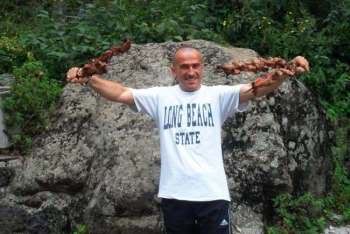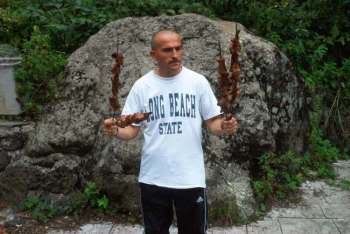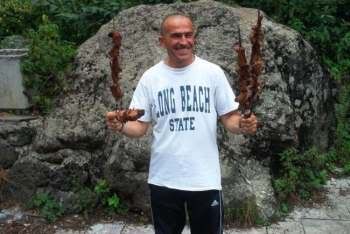International travelers always face the risk of gastrointestinal distress when eating strange new foods or drinking the waters of foreign lands. Americans who visit Mexico call it “Montezuma’s Revenge.” Visitors to Armenia have yet to come up with a specific name for this inconvenient and often embarassing malady. Armenians call it
loots.
My first
loots affliction came during a visit to Armenia’s famous mineral water resort, Jermuk. I suspected the water I had drunk from a street fountain by Yerevan’s main bus station. Then I wondered if it might have been the kebab I dined on in a café-in-a-cavern next to Jermuk’s big gorge-spanning bridge. Or perhaps it was the iron-rich volcanic fountains of Jermuk itself that I had drank from in the Hall of Waters. I don’t know. Whatever the cause, I was soon trapped in my hotel room’s lavatory, my head between my ankles in cramped misery. Irina was pounding on the bathroom door, and I wish I had a 10-dram note for each time she called out, “ARE YOU FINISHED?” No, I wasn’t finished, heaven help me.
My second time of troubles was after I ate a piping-hot, deep-fried
ponchik, Armenia’s version of a Krusty Kreme doughnut. I bought it from a street vendor, and it looked and tasted great. I don’t know what kind of oil was used to cook that fried fritter, but it must have been spiked with some good old Soviet-era motor lubricant, or else some of that awful, indigestible, invented-in-the-West Olestra stuff. Thank heaven it occurred on a day of full water service and I was able to flush the toilet at 15-minute intervals.
Armenians have lots of folk remedies for diarrhea, and many were given to me as I thrashed and grimaced in my sorry state. The common remedy is pomegranate juice, and soon my lips were stained red from drinking so much of it. But to no avail. My insides continued making rude noises, and no one dared come between me and the bathroom.
Next, a strong solution of boiled mint leaves was prescribed, but it, too, failed to settle my internal eruptions. In desperation, I put myself on a diet of plain boiled rice, and this did provide some relief. But my digestion flared up again in the worst way after my very next meal of Armenian food.
Finally, a trip to the
apteka, the pharmacy, yielded a packet of Immodium, and my
ponchik-induced diarrhea came to a halt. Unfortunately, my entire digestive system shut down for about three days after taking the medicine. I began to fear I had gone too far in the other direction, and that I’d have to get more
ponchikis to resume my normal bodily functions. But, at last, my intestinal tract regained its equilibrium, and I was able to enjoy Armenia’s delicious cuisine once again without fear of the consequences.
“Vengeance is mine, sayeth the Lord,” and it was really not my intention to make revenge upon my Armenian friends and family when I treated them to some American food. In my luggage I had packed a big jar of McCormick’s Chili Powder, a couple of boxes of instant Potatoes Au Gratin, and, for dessert, two whip-and-chill Cheesecake mixes.
The kitchen was filled with curious Armenian spectators as they watched this foreigner cooking a huge caldron of Indiana-style chili. Unlike our American neighbors to the South and West, Midwesterners like me include macaroni and kidney beans in our chili. Such would be considered blasphemy by Texans and other chili purists. But I knew my Armenian guests wouldn’t protest my recipe. In fact, they eagerly lined up with bowls in hand when the chili was ready, and the big pot was emptied within a half hour. The second course, Potatoes Au Gratin and Ham, was also downed as fast as it could be served.
I thought the dinner had been a great success, and I was quite proud of my efforts as an unofficial ambassador of American cookery. Then I began to notice them going back and forth to the house, some faster than others. “
David-jan, es inch du beretsir mer glukh?” meaning “David, what did you do to us with that concoction? We didn’t do anything bad to you. Why were you so cruel to us?” I learned that all who had partaken were lined up at the bathrooms. Young and old, all were laid low with the trots. Perhaps I should have warned them not to eat two or three bowls of chili one after the other, as many of them had done. Maybe I should have spaced out the servings over a few days, and not done a full-blown American dinner all at once. Who knows?
A wise person learns from his or her mistakes. Here are a few guidelines and some insider tips for those who may find themselves in, well, an uncomfortable situation:
1. Train yourself in the lexicological intricacies of diarrhea. The term for diarrhea in Armenian is
loots, but never use it as a verb. Turned into a verb,
lootsel, the word means to solve a problem or a math question. “I got into
loots” means “I have diarrhea.” Note: you do not have it; you got into it, which intensifies the drama.
Another colloquial expression is
tsrel. But it probably shouldn’t be used in polite company. It is considered gross and rude. In Armenian slang, cowards and fraidy cats are called
tsran because, well, you know what can happen when a person is suddenly frightened and needs to change clothes.
2. Don’t use Pepto Bismol in public. It is not sold in Armenia, but it is well known as the “pinky tablets.”
Artasahmansti, foreigners, have gained a wimpy, sissy reputation for always “washing their food down” with the pink bismuth tablets, for not being able to digest food naturally. If you must take medication, do so discretely, not at the dinner table.
3. If you are stricken with diarrhea while visiting an Armenian home and you are offered any home remedies, ask for preserves made of
panda, Armenia’s small, wild pears. They are quite delicious, and they really can fortify one’s constitution. Armenian women keep
panda preserves on hand for “tightening the stomach.”
4. Remember that water from public fountains and meat purchased from street vendors can cause
loots. But don’t believe all the stories you may hear about digestion-wrecking Armenian foods. For example, once we were invited to a friend’s house in Yerevan for dinner. Irina was in the kitchen with the other women, helping prepare the evening meal. I heard lots of laughter, and it went on and on. When Irina sat next to me at the dinner table, she whispered, “See that bright green pepper? Don’t you dare touch it. Don’t shame me.” She later explained why.
Our hostess had been telling the gals in the kitchen that she once worked as an administrator at the Erebuni Hotel in Yerevan, during Soviet times. She said that the word
tsitsak (long green peppers) was a code name for diarrhea among the hotel staff. The cleaning personnel hated
tsitsak. They blamed it for the extra cleaning and linen laundry they had to do after foreign guests ate their fill of the spicy peppers.
I was somewhat skeptical about this story, having eaten my share of spicy chili peppers with no regrets. So, at a later date I tried the tasty, hot green
tsitsak. Nothing happened to me. I suspect that the true source of the hotel guests’ miseries and embarassment was the meat they were eating along with the fresh peppers. Nonetheless, brave souls who wish to test the
tsitsak might consider doing so in isolation, like I did.
5. No matter what, no matter what anyone tells you, carry some toilet paper or paper tissues with you. While Yerevan’s public toilets are slowly improving, especially in the downtown area, you will still have to buy a cup of coffee to gain access to a café bathroom. Better yet are the city’s major landmarks. At the Cascades, a cleaning lady immediately follows to tidy up after you’ve used the restrooms. The same is true at the Tashir Trade Center, though you’ll have to pay the restroom matron 50 drams up front for the meager ration of four or five sheets of toilet tissue. So don’t give away all your small change.
DAVID UNDERWOOD
If you’d like to learn more about
tsitsak, panda, and traditional food remedies in Hayastan, read our book,
ARMENIAN FOOD: FACT, FICTION & FOLKLORE, ISBN 1411698659, by Irina Petrosian and David Underwood.
Technorati tags: Armenia, Armenian, Armenian Food, Food, Cuisine, Culture, History












